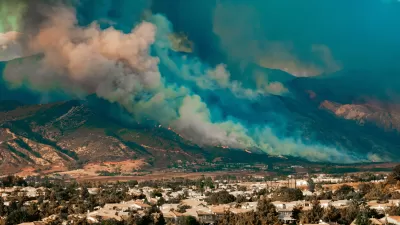In the works since 1999, the Centennial Project by Tejon Ranch Co. seemed to have cleared its final hurdle in 2018, but a Los Angeles County court ruling has created another hurdle for the sprawling development.

Los Angeles County Superior Court Judge Mitchell Beckloff rejected the environmental impact report (EIR) for the massive Centennial project planned for northern Los Angeles County, one of the most controversial and closely watched master planning developments in Southern California in recent memory.
Louis Sahagun reports on the latest twist in the long saga of the Centennial project, a proposal approved by the county of Los Angeles to allow Tejon Ranch Co. to build 19,300 homes on 6,700 acres on the border with Kern County to the north.
The county approved the EIR for the project in 2018, a decade after a historic agreement between the developer and environmental groups cleared the way for the developer to move forward free of resistance from most of the high-profile conservation organizations.
Since the approval of the EIR, the project has been frequently referenced in conversations about development in the state's wildland-urban interface as wildfires have worsened around the state in recent years. The court decision specifically cited wildfire risk, in addition to the greenhouse gas emissions caused by additional vehicle miles traveled as a result of the project, in its decision.
"Beckloff found that the environmental review failed to buttress its conclusion that the project would not significantly increase the risk of wildfire in a region prone to wildfires. Although the judge found the developer’s on-site analysis to be 'sufficient,' he found discussion of surrounding off-site impacts, such as wind-driven embers, to be 'problematic,'" explains Sahagun in more detail. "The judge also found that the developer mistakenly claimed that the cap-and-trade program would reduce 96% of its greenhouse gas emissions, which cause climate change."
Sahagun also reports that the developer isn't abandoning the project, stating after the ruling its intentions to work with the county to resolve remaining issues in the project proposal.
FULL STORY: Citing high wildfire risk, judge halts construction of massive Tejon Ranch development

Alabama: Trump Terminates Settlements for Black Communities Harmed By Raw Sewage
Trump deemed the landmark civil rights agreement “illegal DEI and environmental justice policy.”

Planetizen Federal Action Tracker
A weekly monitor of how Trump’s orders and actions are impacting planners and planning in America.

The 120 Year Old Tiny Home Villages That Sheltered San Francisco’s Earthquake Refugees
More than a century ago, San Francisco mobilized to house thousands of residents displaced by the 1906 earthquake. Could their strategy offer a model for the present?

Rural Population Grew Again in 2024
Americans continued to move to smaller towns and cities, resulting in a fourth straight year of growth in rural areas.

Safe Streets Grants: What to Know
This year’s round of Safe Streets for All grant criteria come with some changes.

Rural Missouri Transit Service Could Lose State Funding
OATS Transit offers low-cost rides to primarily elderly rural residents with little or no access to other transportation options.
Urban Design for Planners 1: Software Tools
This six-course series explores essential urban design concepts using open source software and equips planners with the tools they need to participate fully in the urban design process.
Planning for Universal Design
Learn the tools for implementing Universal Design in planning regulations.
Clanton & Associates, Inc.
Jessamine County Fiscal Court
Institute for Housing and Urban Development Studies (IHS)
City of Grandview
Harvard GSD Executive Education
Toledo-Lucas County Plan Commissions
Salt Lake City
NYU Wagner Graduate School of Public Service





























